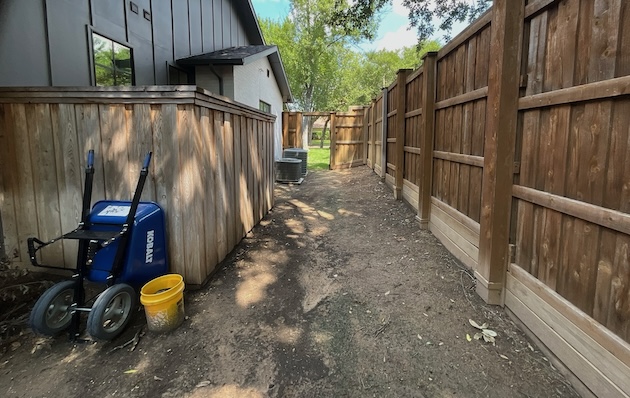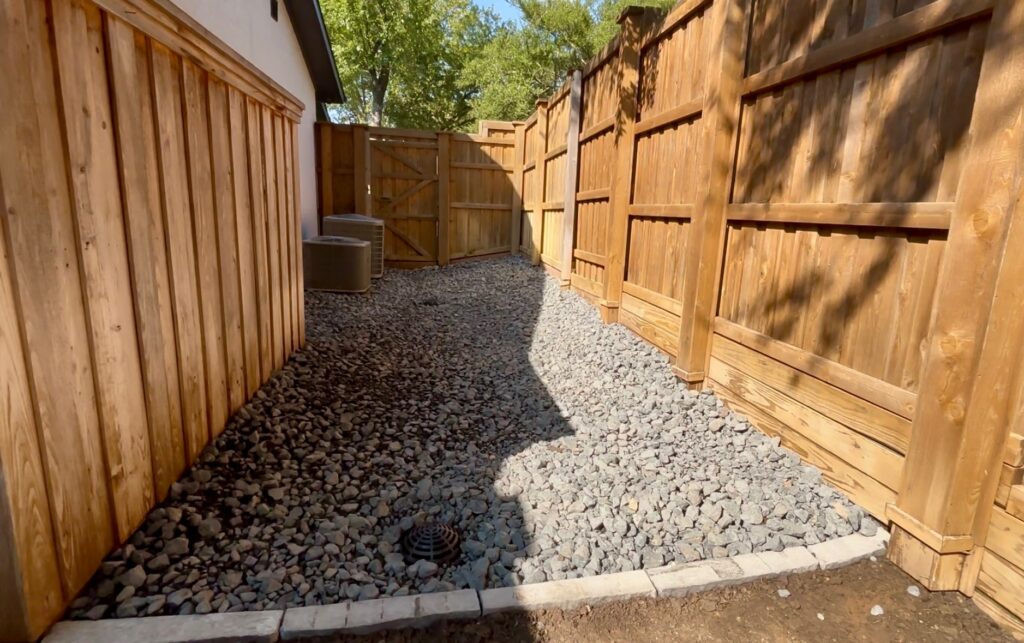Specializing in Stormwater Drainage Solutions
Dallas Drainage Pros – How to Deal with a Constantly Muddy Side Yard
You've got lots of shade, bad slope, and nothing will grow - what do you do?
How to Fix a Muddy Side Yard Using Grading, Gravel and a Drainage System
A muddy side yard isn’t just an eyesore—it’s a sign that water isn’t draining the way it should. Persistent puddles, soggy soil, and slippery walkways can damage your lawn, attract mosquitoes, and even threaten your home’s foundation. Fortunately, the solution doesn’t always require tearing everything out. With proper grading, gravel installation, and a well-designed drainage system, you can turn that muddy mess into a clean, functional, and dry area.
1. Start with Proper Grading
The foundation of any drainage solution begins with grading—shaping the soil to direct water away from the house and toward a suitable discharge point. A general rule of thumb is to have an overall slope of 1–2%, meaning the yard should drop about 1–2 inches for every 10 feet of horizontal distance. (Building codes recommend 5% slope directly away from your house, but once this water is far enough away from the foundation, it can travel at 1–2% slope.
Start by identifying the low spots where water collects. Using a long level or laser level, regrade these areas so that surface runoff flows away from your foundation and not toward it. In many Dallas-area properties, the clay soil makes this even more important; when saturated, it expands and can push water back toward the structure. Maintaining a steady slope and firm compaction helps prevent this reverse flow.
2. Add a Gravel Layer for Stability and Filtration
Once the grade is set, add a layer of gravel or river rock—what size you use will depend on your objective (and some personal preference), keeping in mind that smaller gravel is easier to walk on, but larger rock is more ideal for retaining steeply sloped areas. Gravel serves multiple purposes:
-
It stabilizes the walking surface.
-
It prevents erosion.
-
It allows water to percolate through rather than pooling on the surface.
In narrow side yards that see lots of foot traffic and/or don’t receive enough sunlight because the house and fence provide too much shade, gravel also reduces mud tracking. For the best results, install a non-woven, geotextile fabric beneath the gravel. This particular type of barrier fabric not only prevents the gravel from sinking into and mixing with the clay, it also allows rainfall to still filter through to the soil (you want some water, just not the additional runoff from other areas.)
3. Install a Subsurface Drainage System
When grading and/or grave alone aren’t enough—especially in flat or enclosed side yards—a surface drain or a French drain system can make all the difference.
A surface or french drain consists of a solid or perforated drainage pipe and catchment or collections systems. We have many articles and videos on different types of systems, and each situation may call for a different solution. The point is, that these systems help collect either surface water or groundwater (or both), redirecting it away from the problem area, to an area where water should go, like an alley, street or easement.
For paved or tight areas, a channel drain across the walkway can intercept surface water and tie into the same discharge line. The key is ensuring at least a 1% slope throughout the piping system so water flows continuously and doesn’t stagnate.
4. Direct Water Safely Away
The final step is to make sure all that collected water has a safe place to go—ideally toward the street, a creek, or a public easement. Avoid routing it toward neighboring properties (where it will create an issue for somebody else) or to another low spot in your yard, where it will simply cause a problem in a new/different area of the property.
In short: dealing with a muddy side yard comes down to controlling where water goes. Proper grading directs it, gravel filters and stabilizes it, and a well-built drainage system carries it away. Done together, these three components transform a perpetually soggy side yard into a clean, usable, and long-lasting space that protects your home year-round.
Before:

After:

